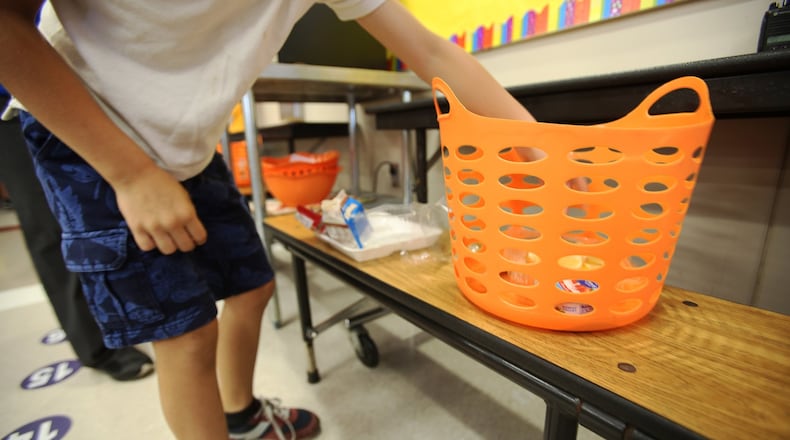As 9-year-old Sabrina Agosto left her school’s lunch line, she dropped her carton of milk on the cafeteria’s “share and donation” table and then snagged an extra yogurt.
“I don’t like milk,” explained the fourth grader at Aloma Elementary School in Orange County. “I really like them,” she said of her twin containers of strawberry yogurt.
Lunchtime at Aloma means a steady stream of youngsters putting items they don’t want on the table and picking up extras of things they do like. On a recent afternoon, containers of milk and yogurt, wrapped cheese sticks, and packages of crackers, orange slices, and coleslaw all came to and then left the table.
Whatever isn’t picked up by students is donated to a nearby church that gives the food to the homeless.
The 2-year-old effort aims to eliminate food waste and to provide extra nutrition both to hungrier kids in the cafeteria and to needy residents in the community.
Aloma is one of about 20 public elementary schools in Orange that have started a so-called share table. Some, like Aloma, donate their excess to charities and others send the food — which cannot, by law, be reused in the lunch program — home with students whose families struggle to make ends meet.
Most of Osceola County’s public elementary schools, and a few in Lake and Seminole counties, run share tables, too, though they don’t all send leftovers to charities.
The U.S. Department of Agriculture, which oversees the federal lunch program, endorsed “share tables” as an “innovative strategy” that food service directors should consider in a June 2016 memo.
“Without this program, that would literally go in the dumpsters,” said Pastor Stan Reinemund of Redeemer Lutheran Church, about a mile from Aloma’s campus and the beneficiary of the school’s leftover food.
Once a week, he picks up Aloma’s donations. His church puts some items in its food pantry and uses others for a Sunday breakfast served free to about 100 homeless people every week.
“It really helps us out,” Reinemund said.
Under the federal school lunch program, students must take a certain number of items as they go through the cafeteria line, including a fruit or vegetable. But students don’t always want everything they’ve had to take, said Lora Gilbert, senior director for food services at the Orange school district.
The schools must also serve the same size meals to kindergartners, for whom the lunch may be too much, and to much-larger fifth graders, for whom it might not be quite enough, she said.
The share table seeks to solve those problems without filling trash cans.
Riley Wiggins, 9, dropped his orange slices on Aloma’s table “because I don’t like oranges.” But the fourth grader said that when carrots are on the menu, he sometimes grabs a second serving.
Another Aloma student grabbed extra packages of oranges and coleslaw and a second cheese stick off the table, sat down and ate it all. Maybe, Gilbert said, he doesn’t get much at home, but at least at lunch he could eat plenty of nutritious food.
“We don’t want to see any child hungry,” she added.
The federal school lunch program provides free and reduced-price meals to youngsters in low-income families and allows others to purchase them, with lunch in an Orange elementary school costing $1.90. Under federal rules, schools with lots of youngsters from poor families also can opt to serve free meals to everyone, and that’s what Aloma and many other Orange schools do.
Parent Shannon Miller, who volunteers in Aloma’s cafeteria about once a week, said her fourth-grade daughter often picks up an additional milk from the share table. She likes that the program means good food is “not just going in the trash.”
Because of state health-code requirements, the share tables cannot accept hot food or food that isn’t in sealed containers, Gilbert said.
But Aloma gets most of its food from one of the district’s central kitchens, so even fresh fruit usually arrives sliced and individually packaged. Those items can go on the table along with anything else that is sealed in its own container.
Staff keeps cold items fresh with ice-pack-lined trays and a small refrigerator donated by the Winter Park Health Foundation.
Martha Albright, Aloma’s cafeteria manager, said the share table has cut down on waste and mess in the lunch room because students don’t play with and then throw out food they don’t want to eat.
“The custodians love it,” she said.
“The share and donation table is just terrific,” added school board member Linda Kobert, “to serve our other students or to go back into the community.”
About the Author
Keep Reading
The Latest
Featured


